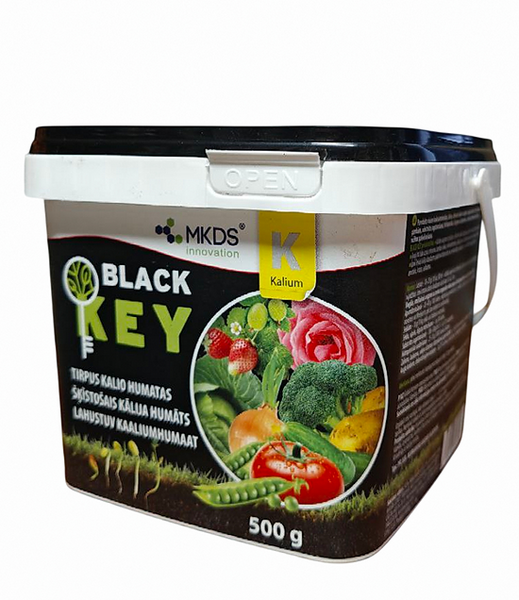Active ingredient: potassium salts of humic acids.
500 g = 500 m2.
Has the following properties:
* Increases germination energy and seed viability.
* Stimulates plant growth and development.
* Protects plants from adverse factors, frost, drought and increases plant survival when transplanting seedlings.
* Reduces nitrate content in fruits, neutralizes radionuclides and heavy metal salts.
* Increases yields by 30-40%, increasing the content of vitamins and other useful substances in vegetables, berries and fruits.
* Accelerates ripening by 7-10 days.
* Plants absorb soil moisture, nutrients and microelements very well, and also better tolerate stressful growth conditions associated with drought.
* High potassium content accelerates photosynthesis and amino acid production, which affects the quality of the fruit: aroma, color and taste.
Timing of treatments according to the phases of plant development: before and after flowering, at the beginning of ovary formation, in the phase of intensive fruit growth.
The guaranteed shelf life is unlimited.
Basic instructions for using potassium humate.
When watering: 10-25 g / 10 l / 100 m2 - open ground and greenhouses (for all plants), every 2 weeks as needed. The recommended amount of water for irrigation is 10 l / 100 m2 (on light sandy soils with a low content of organic matter, the application rate can be increased by 25%).
When spraying - 20-40 g / 100 l of water, every 2 weeks during the growing season (let the prepared solution settle or strain it, then pour it into a sprayer).
For soaking seeds, cuttings, bulbs and feeding seedlings - 5 g / 10 l of water.
For preparing a nutrient soil mixture - from 100 to 500 g / m3 (1-5 g / 10 l of substrate).
For hydroponic cultivation - 25-50 g / 1000 l of working solution.
To improve the development of the root system of lawns, fields and areas by spraying - 2-4 g / 10 l / 100 m2 (every 2 weeks as needed).
Fruit trees, ornamental trees - 3 g / 10 l / tree, water every 2 weeks as needed. Dosage: a full measuring spoon (located inside the package) corresponds to 6.0 g of product.
Dosage: a full measuring spoon (located inside the package) corresponds to 6.0 g of the product.
* The use of humates is necessary for all types of soil and for all types of plants. When using manure or plant residues to prepare compost, it should be borne in mind that humates promote the growth of microflora, primarily actinomycetes (microorganisms that combine the properties of fungi and bacteria), which are capable of breaking down wood residues (cellulose, hemicellulose, proteins and lignin), thereby accelerating the processes of natural humus accumulation.
Three months before applying to the soil, it is useful to treat manure, humus and compost with a humate solution at the rate of 0.8-1.0 kg of humate per 1 ton of manure or 2.5 kg of humate per 1 ton of compost mass, which allows you to speed up the compost formation process and reduce their consumption.
When are humates used?
Annual plants react more strongly to the introduction of humate at the beginning of their development and at the time of formation of reproductive organs. Woody plants - after transplanting seedlings and saplings, when the root system is injured. The same applies to vegetable and ornamental seedling crops. Humates are used at all stages of plant development.
They start with soaking the seeds. For this, it is recommended to prepare a solution of 0.5 g per 1 liter of water and soak the seeds in it for a day. Soaking of annual flowers (asters, verbena, salvia, petunias, nasturtiums, carnations, etc.), as well as "babies" of gladioli, cuttings of balsams, physalis, dahlias, hydrangeas should be done during the day at a temperature of +20+22°C. Further treatment with humates is carried out during the growing season. In this case, the consumption of humate is largely determined by the natural origin of the plant itself. Crops such as dill, parsley, lettuce, onions, radishes and sorrel require a small amount of nutrients. Therefore, it is enough to water them 3-4 times during the summer with a 0.01% solution, using 2-3 liters per 1 m2.
Cucumbers and tomatoes are plants with an average nutrient consumption. They are watered with a 0.01% humate solution when planting seeds and then regularly every 2 weeks.
At the same time, for tomatoes, if after planting the seedlings the stem thickens significantly and the size of the leaves increases, it is better to use humate by spraying the flower stalks, and not to give it under the root.
All types of cabbage, peppers, carrots, beets, zucchini and squash require a high level of nutrients, so watering once a week is recommended.
For fruit and berry crops, foliar feeding with humate is recommended at least 6 times per season: before the leaves bloom, in the budding phase, after flowering, when flower buds are formed, and (twice) in the phase of intensive fruit growth.
Wood seedlings and saplings are treated with humate during transplantation, soaking the roots of the cuttings for 24 hours, lowering them into the humate solution by 1/3 of their length at a temperature of at least +20°C (and then watering them again a week after planting).
How to use humates?
The correct use of humates is the key to success. Humic preparations are effective only in strictly defined doses, and if they are exceeded, the plants slow down their growth and may even die.
There are three options for treating with humates: soaking or spraying seeds, foliar treatment (spraying), and root treatment.
We recommend the following system of humate distribution by plant treatment methods. Based on the above humate consumption rates for each plant type, you must first allocate 2-3% of the total dose for seed treatment, then determine the maximum amount of humate that you can apply by foliar feeding - spraying, and the rest of the dissolved humate can be used for root feeding (the finished concentrate can be stored throughout the spring-summer season).
* If the year was bad or you planted plants in low-quality soil, then the use of potassium humate can work a real miracle!
It is important to note that:
Potassium humate is highly effective on alkaline and neutral soils, but is ineffective on acidic soils.
It is also not recommended to use Potassium Humate on fertile soils (chernozem).
Potassium humate is a highly effective and technological humic fertilizer enriched with important microelements. An excellent growth stimulant and anti-stress agent.
Potassium humate has a wide range of effects on plants. Its properties are manifested on almost all agricultural crops.
The use of potassium humate in agriculture allows:
Increase crop yields (depending on the crop) by 10-25%
Improve the quality of agricultural products (gluten, sugar content, vitamin C in vegetables)
Strengthen plant immunity
Increase frost and drought resistance by increasing the root system of plants
Increase the efficiency of seed treatment together with seed dressings (increases field germination of seeds, increases pathogen suppression, increases plant immunity)
Relieve stress in plants by increasing the efficiency of foliar treatments with pesticides and complex mixtures (stimulates growth and development, relieves stress during complex treatments, stimulates the process of photosynthesis)
Increase the efficiency of mineral fertilizer use (increases the coefficient of nitrogen, phosphorus, potassium use).
Crops that respond particularly strongly to the application of potassium humate:
* all nightshades (potatoes, tomatoes, eggplants, etc.)
* table and fodder beets
* all grain crops also show a significant increase in yield.
Crops that respond weakly to potassium humate:
* Legumes show virtually no change in performance (for legumes, it is better to use ammonium molybdate).
* Sunflower and pumpkin do not respond to potassium humate, its use is impractical.












